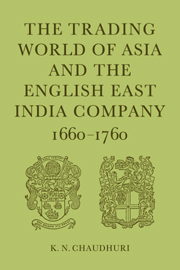Book contents
- Frontmatter
- Contents
- Tables
- Figures
- Maps
- Abbreviations
- Notes on dates, contemporaneous spellings, currency, and weights
- Preface
- Acknowledgements
- 1 The international economy and the East India trade
- 2 A formal theoretical model of the East India Company's trade
- 3 The structure of early trade and the pattern of commercial settlements in Asia
- 4 The evolution of the Company's trading system: operation and policy 1660–1760
- 5 Long-term trends and fluctuations 1660–1760
- 6 Politics of trade
- 7 Markets, merchants, and the Company
- 8 The export of treasure and the monetary system
- 9 The structure of country trade in Asia
- 10 Export of European commodities
- 11 The Company and the Indian textile industry
- 12 The Company's trade in textiles
- 13 Pepper
- 14 Import of bulk goods
- 15 Raw silk
- 16 Coffee
- 17 Imports from China
- 18 Financial results
- 19 Conclusion
- APPENDICES
- General glossary
- Bibliography
- Short titles cited in the reference notes
- Notes
- Index
14 - Import of bulk goods
Published online by Cambridge University Press: 06 July 2010
- Frontmatter
- Contents
- Tables
- Figures
- Maps
- Abbreviations
- Notes on dates, contemporaneous spellings, currency, and weights
- Preface
- Acknowledgements
- 1 The international economy and the East India trade
- 2 A formal theoretical model of the East India Company's trade
- 3 The structure of early trade and the pattern of commercial settlements in Asia
- 4 The evolution of the Company's trading system: operation and policy 1660–1760
- 5 Long-term trends and fluctuations 1660–1760
- 6 Politics of trade
- 7 Markets, merchants, and the Company
- 8 The export of treasure and the monetary system
- 9 The structure of country trade in Asia
- 10 Export of European commodities
- 11 The Company and the Indian textile industry
- 12 The Company's trade in textiles
- 13 Pepper
- 14 Import of bulk goods
- 15 Raw silk
- 16 Coffee
- 17 Imports from China
- 18 Financial results
- 19 Conclusion
- APPENDICES
- General glossary
- Bibliography
- Short titles cited in the reference notes
- Notes
- Index
Summary
The general role of bulk goods
Apart from pepper the East India Company imported a number of other bulk goods, often described in the records as coarse or gruff goods. Indigo and saltpetre were the most important among them. Although the first ceased to be imported regularly after 1712, saltpetre continued to be in demand throughout the period, and its procurement came to occupy a sensitive place in the correspondence between the Court of Directors and the Bengal servants. Among other commodities which appear on the Company's import list of bulk goods were the various kinds of gum resins - aloes, myrrh, lac, and olibanum - benzoin, cotton yarn, redwood, sandalwood, sugar, and wool from the Kirman province of Persia. If pepper and calicoes were the staple items of the East India trade in the seventeenth century, these goods also served to diversify the commodity base and added an exotic touch to the Company's regular sales in London. But the direct commercial appeal of the bulk goods was far surpassed by their indirect importance in the Company's trading system. It has already been pointed out that even pepper, which had an independent and continuous demand in European markets, performed almost as vital a role in the economic calculations of the Company's shipping as ballast cargo. However, pepper was not obtainable everywhere. Nor was it always convenient to tranship it from one port to another because of the risk of damage. Pepper was generally shot loose between the bales in the ships' holds and the movements of the bales tended to grind the peppercorns into dust.
- Type
- Chapter
- Information
- The Trading World of Asia and the English East India Company1660-1760, pp. 329 - 342Publisher: Cambridge University PressPrint publication year: 1978



